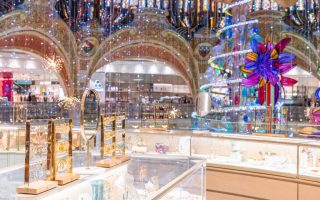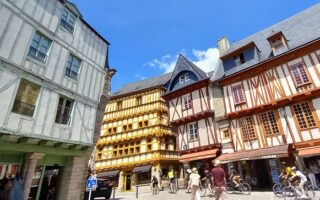Vintage in the Village
The celebrated Marché aux Puces de Saint-Ouen, known by Parisians as les Puces de Clignancourt or simply aux Puces, received a welcome injection of new life in June with the inauguration of the chic new Village Vintage, spearheaded by the iconic European furniture giant Habitat and the cutting-edge Paris fashion boutique L’Eclaireur. Housed in a gated courtyard of old ateliers and warehouses that once served as holding spaces for local vendors and high-end Paris dealers – including chandeliers destined for the swanky Paris showrooms of Maison Steinitz – Village Vintage projects a decidedly more upscale image and seeks to draw a younger, trendier fashion-conscious crowd.
This is good news, if not for disillusioned bargain hunters, who nowadays often forego Saint-Ouen for other markets, like Vanves and even gritty Montreuil, certainly for the Puces itself. Although still popular among hardcore seekers and tourists, the storied 150-year-old antiques market – the largest in the world – has experienced a steady decline in the last 10 years, with eBay and bargain retailers whittling away at its client base, but also in part a victim of its own success. From its heyday in the 1970s and 1980s, prices seemed to increase in tandem with the market’s popularity, pricing out Saturday strollers and antiques lovers on a budget in favour of high-end dealers replenishing Paris shops and wealthy foreign buyers.
As much as prices seem increasingly geared toward a clientele willing to shell out the bucks, the Puces remains resolutely threadbare, recalling its hardscrabble past as the place where chiffonniers (rag pickers) could hawk their wares on blankets laid out on the ground outside the city gates and the purview of city health inspectors. In the 1920s, the market – finally reachable by the Paris Métro– introduced the covered stalls that remain today. But it wasn’t until just after World War II that the rag-and-bone men of the Puces were replaced by brocanteurs – dealers in second-hand furniture and whatever else of interest they could scrounge up. The oldest, Vernaison, Biron and Malik, are separate entities unto themselves. In fact, the Puces is actually a maze of some 16 distinct markets, most of them accessible via the Rue des Rosiers, the area’s central spine and a handy point of reference for visitors disoriented by the rabbit warren of tiny stands.
But getting lost in the market’s labyrinthine allées is all part of the fun. The baffling system of numbered stalls and passageways – a vestige of the old days – is fundamental to Saint-Ouen’s down-the-rabbit-hole ambiance and a cherished relic of the market’s history, the only flea market in the country with the protected status of “architectural heritage zone.” French to its core, a convivial mood prevails among merchants who banter and engage each other like neighbours over a fence, enjoying a game of bridge or lunch and a bottle of wine, with no great concern over empty stalls.
Despite the entrenched nostalgia, a younger, more enterprising group of design-savvy dealers has been quietly forsaking the bric-a-brac strewn image of the fleas in favour of stylish mini-boutiques that project a distinct ambiance and lend the flea market a frisson of drama and calculated chic. Some minimalist, others with a sort of Baroque eclecticism, the new generation tends to offer handpicked wares artfully displayed for maximum appeal. What has been lost in terms of the thrill of the hunt is more than made up for in uniqueness and originality. Here the work is done for you – at a price that design-conscious buyers are willing to pay. All this has set the stage for the next phase in the Puces’ renaissance.
Enter Village Vintage
Situated at the heart of the Puces, at 77 Rue des Rosiers, Village Vintage’s graffiti-splashed, sphinx-topped gates open onto a spacious courtyard enclosed by old warehouses in various stages of artful decrepitude. That’s just the outside. Inside these are by far the most deluxe spaces to be found at the Puces, with an industrial modern appeal and a clean, functional atmosphere all the better to highlight vintage-modern treasures. Although to date the village is home to only four merchants, and the sleek Café Kluger there are many rumoured to be on the way (including a vintage Dior shop). With nearly 270,000 square feet of available space, the potential is huge.
And that’s what the forces behind Village Vintage are banking on. Brainchild of Hervé Giaoui, president of the Cafom Group, who now own Habitat France (the UK company is under separate leadership), the idea was to inaugurate a space “entirely dedicated to the most prestigious brands in fashion, accessories and design… where [vendors] can create their own space and sell the iconic products that marked their history.” For Habitat 1964, this means a return to the company’s heyday when it was the go-to place for affordable, urban home furnishings.
A trailblazer for accessible European design from the 1960s into the 1990s, Habitat reflected its founder Terence Conran’s devotion to simplicity of style, natural materials and a bright, youthful colour palette ushered in an era of contemporary design that’s never gone out of style. It also provided the template for later retailers, like Conran’s eponymous Conran Shop, an upscale version of Habitat, and IKEA.
In honour of its 50th anniversary, Habitat 1964’s 5,000-square-foot concept store is offering 50 years of the company’s iconic pieces, no longer in production, including the clip-on desk lamp (1980) and Mushroom lamp (1977), the Altona desk (1993) and a selection of signature pieces in steel, wicker and leather along with smaller household items, like brilliantly coloured glassware and vases. The pieces were selected for lasting value; the immediately recognisable classics representative of Habitat’s – and Sir Terence Conran’s – enduring philosophy: “plain, simple and useful.” We might add stylish and beautiful.
If there were any doubts about this project’s high-concept creds, L’Eclaireur’s sumptuous boutique in a charming vine-clad atelier should put them to rest. Another founding pioneer at Village Vintage, this is the seventh Paris outpost of renowned style innovators Martine and Armand Hadida’s trailblazing boutique (the name means “guide”), which has led the Paris fashion avant-garde for 30 years.
Still blurring the line between fashion, art and design, the uncluttered space houses L’Eclaireur’s contemporary archives from the 80s to 2000 – including vintage pieces from Balenciaga, Oscar de la Renta, Dries Van Noten, Anne Demeulemeester and Martin Margiela – while also serving as a gallery space for top-tier contemporary furniture and accessories designers.
Just next door, Galerie Gam specialises in the leading lights of 20th-Century French furniture design from the 50s through the 70s that owner Ayann Goses has collected over decades of obsessive market combing. Here prestigious names like Jean Prouvé, Charlotte Perriand and Serge Mouille rub shoulders with a selection of objects chosen for pedigree, style and flair.
Mademoiselle Steinitz’s industrial warehouse across the courtyard also champions a mix of art, design and fashion.
Helmed by Sarah Steinitz, daughter of the esteemed Paris antiquaire Bernard Steinitz, the spare concrete space makes an excellent backdrop for Steinitz’s handpicked – and wonderfully eccentric – selection of unique vintage furniture, sculptures and contemporary photography interspersed with outstanding vintage gowns from designers such as Madame Grès, Jean Patou, Alaïa and Chanel.
What transformation would be complete without satisfying that most crucial of matters – where to eat? It’s only natural that Philippe Starck, native son and a devotee of the Puces since his teenage years, would step in to fill the gap. Starck’s stylish Ma Cocotte restaurant is both a perfect reflection of the Puces and like nothing it’s seen before. The roomy warehouse space is divided into several cozy dining rooms, including two large outdoor terraces, that draw upon flea market tropes for its homey yet modern interiors, a little like dining in a chic Paris apartment. Modelled as a place where “people can get a hot chocolate or a bowl of soup after bargain hunting on a cold winters day” (not to mention a glass of Champagne and a solid bistro menu), on a cool rainy day in June, just after the opening of Village Vintage, barely a soul had braved the market but Ma Cocotte was teeming with Paris hipsters. Having single-handedly created a nighttime scene at the Puces, Ma Cocotte is now a destination unto itself.
It’s yet to be seen how the renaissance of Saint-Ouen will play out. But with the exciting new Village Vintage revitalising the scene and drawing in an enthusiastic new crowd, it’s a good bet that everyone in the area is in for better days ahead.
Originally published in the October-November 2013 issue of France Today
Share to: Facebook Twitter LinkedIn Email
Leave a reply
Your email address will not be published. Required fields are marked *





